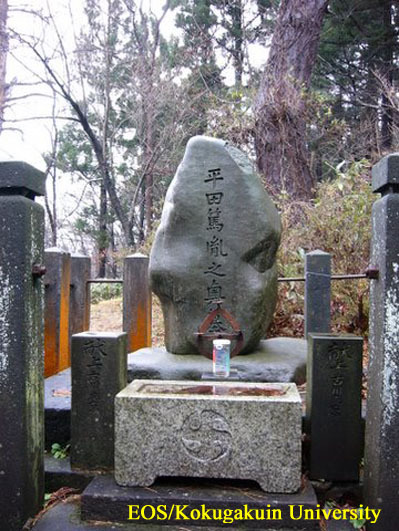- トップ
- Encyclopedia of Shinto
- Hirata Atsutane
Encyclopedia of Shinto
| Main Menu: | |
| Links: |
詳細表示 (Complete Article)
| カテゴリー1: | 8. Schools, Groups, and Personalities |
|---|---|
| カテゴリー2: | Personalities |
| Title | Hirata Atsutane |
| Text | (1776-1843) Scholar of National Learning (kokugaku) of the late Edo period. He had numerous epistolary names, including Daigaku and Ibukinoya, and together with Kada no Azumamaro, Kamo no Mabuchi, and Motoori Norinaga, he is numbered as one of the "four great kokugaku scholars" (kokugaku yondaijin). Hirata was born on the twenty-fourth day of the eighth month of 1776 as the fourth son of Akita Domain retainer Ōwada Yoshitane, but little is known of his early years. He left his home domain in 1795 and moved to Edo, where in 1800 he became the adopted son of Matsuyama retaijner Hirata Tōbei. In 1805 he entered the academy of Motoori Haruniwa, although he declared himself a posthumous disciple of Motoori Norinaga, who had died three years before. From 1811, he broke new ground in the study of ancient Japanese traditions, and from around 1820 began work in earnest on foreign traditions as well. His scholarship encompassed many fields, from ancient classics to calendrical calculation, Ijing divination, military science, and Daoism, and he was a prolific writer. Texts that represent his primary intellectual lifework in the study of ancient Japanese traditions include Tama no mihashira (The True Pillar of Spirit), Koshi seibun (Treatise on Ancient History), and the commentaries Koshi-chō and Koshi-den. He is also noted, however, for his work on foreign studies, including studies of ancient Indian and Chinese tradition (Indo zōshi and Morokoshi taikoden), and texts dealing with the spirit world, including Senkyō ibun (Strange Tales of the Land of Immortals) and Katsugorō saisei kibun (Chronicle of the Rebirth of Katsugorō). Hirata also set out his theories in simple language in such publications as Kodō taii (True Meaning of the Ancient Way) and Zoku Shintō taii (True Meaning of Common Shinto). The contents of Atsutane's 1841 treatise Tenchō mukyūreki (Chronicle of the Perpetual Rule of the Emperor) angered the ruling Tokugawa government, and he was sentenced to confinement in Akita Domain. Atsutane died on the eleventh day of the intercalary ninth month of 1843 at the age of sixty-eight, still embittered. After Hirata's death, the superintendent (jingihaku) of the Shirakawa house of Shinto priests conferred on him a posthumous religious title that elevated him to the status of kami. Hirata had five hundred and fifty-three students in his lifetime, and the number of his declared posthumous disciples exceeded one thousand three-hundred and thirty, primarily drawn from the Shinto priesthood and wealthy farming classes. He had a profound impact on the intellectual world of the late Edo period. His scholarly and philosophical writings are collected in the twenty-one-volumes of his collected works Shinshū Hirata Atsutane zenshū, published by the Meicho Shuppan. - Matsu'ura Mitsunobu |




